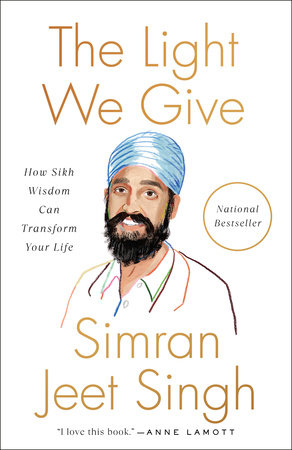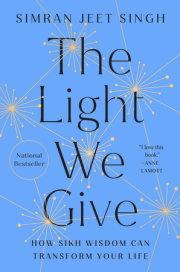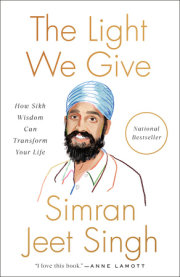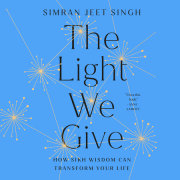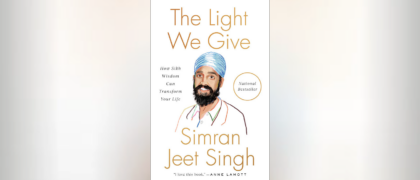It used to bother me a lot when people shared their racist views to my face. My anger would keep me from responding clearly—even responding at all. Even now, as a grown man, I still don't always know the right answer, in part because I believe there's no winning when it comes to racism, and in part because each situation requires its own measured response.
Yet I have developed different ways to meet each racist encounter, confident of who I am and unapologetic about how I look.
I have learned that deflecting ignorance and hate doesn't help anyone, and that we won't ever truly care for one another until we connect with one another. I have also learned that we can't lecture our way into people's hearts, and that opening ourselves up to strangers takes courageous vulnerability. The greatest payoff of sharing ourselves with one another is going beyond our individual experiences and seeing life from other viewpoints. Every day we can give the gift of empathy, to one another and to ourselves.
Sharing our stories is hard and uncomfortable, but as with my choice to wear my turban, I believe the rewards far outweigh the costs. It is in this spirit that I invite you into my own life. My sincere hope is that you might see and feel what it's like to walk in my shoes, as a brown-skinned, turban-wearing, beard-loving, sports-playing dude, trying to create a life of happiness for himself and his family in modern America.
One:
Home? A few years ago, I was just outside my apartment building in New York City when I saw an elderly white woman trip and fall as she was crossing the street. I rushed over to help her and extended my hand. She reached up gratefully, but when she saw the turban on my head she jerked her arm back. Her face scrunched up, then opened back up to release a voice from deep within: "Go back to where you came from!"
I didn't expect my offer to help would trigger such a reaction. When I was younger and heard similar comments, my body would tense up, unsure whether to lash out in anger or shrink back in fear. Though both responses are natural and justifiable in their own way, neither struck me as right in these situations.
Coming face-to-face with hate regularly over the years helped prepare me for this moment. I had come to understand that there are other ways to respond that go beyond fear and anger, a middle path to dealing with the painful moments we encounter that can help us receive hate without internalizing it. While she saw me as a foreigner who threatened her safety, I saw her as I've learned to see all people: a fellow human being trying to bring security, coherence, and joy into her life. Isn't this concern for and interest in one another what makes us human?
Within seconds of the woman's exclamation, I knew what I wanted to do. I called over onlookers to help get her off the street and out of danger, standing by her until she was safe before going on my way.
I chose to care for this stranger, even though she clearly didn't care for me. In a moment when it would have been easier to feel hurt and to walk away, I decided instead to double down on her humanity—and my own.
***
I'm still amused when people tell me to go back to where I came from. It's not that I don't know what they mean, and it's not that I don't know what racism is. I grew up in Texas with a turban, beard, and brown skin, so I've been dealing with racism my whole life. I was born and raised in San Antonio and am an American. My family and I watched American movies growing up. Many of the athletes in the posters that hung on my bedroom walls were American, including David Robinson, Mia Hamm, and Muhammad Ali. I was even terrible at world geography as a kid—and what's more American than that?
Yet when people tell me to go back to where I came from, I know what they mean: You look foreign and dangerous, and we'd feel better if you left.
When it's safe and appropriate, I respond with a tactic that I've come to love over the years: humor.
Sometimes I have a little fun at their expense by putting on a thick Southern drawl: "Well, bless your heart!" I exclaim, drawing out each word as if it had at least two syllables. "My mama would love you. She keeps telling me to move home to Texas, too!"
I watch them squirm with confusion, and before they can figure out what's going on, I reach up to my turban and give it an imaginary tug, as if tipping a ten-gallon cowboy hat.
Other times I might reply earnestly, as if unaware of their malice: "Thank you so much for your thoughtful advice. I really appreciate it."
When people are being especially hateful, I prefer to ignore their nasty comments and continue on with my day, as if I didn't have a care in the world and they didn't exist. Nothing bothers them more than realizing their hate doesn't bother me.
Some friends who don't deal with racism have asked how I can find humor in these moments. I'm never quite sure how to answer that question. From my viewpoint, it's hard to imagine enduring daily provocation without humor.
What I do know, and what many people from marginalized groups also know, is that it's possible to remain calm in the face of hate. One can learn how by maintaining perspective—and with lots of practice.
It has also helped to recognize that people telling me to "go home" says more about them than it does about me. I've come to understand that their words reveal cultural ignorance, that underneath their statement is a pair of twin assumptions: that the United States is not a place for people who look like me, and that there is a place in this world where I truly belong.
***
My parents and ancestors hail from Punjab, a region in South Asia that spans northwestern India and modern-day Pakistan. We speak Punjabi, one of the ten most widely spoken languages in the world. And we eat Punjabi food—roti, daal, sabji, cholay—or at least many of us do. I personally prefer pizza to roti, to the embarrassment of pretty much everyone I know.
My family maintains a distinct appearance as part of our Sikh faith, which is known in the West as Sikhism and in Punjabi as Sikhi. "Sikhi" is the original Punjabi term for the tradition, pronounced with a long e at the end as in "queen." Sikhism is the later English form popularized through colonialism.
In 1469 CE, a boy named Nanak was born to Hindu parents in the village of Talvandi (now Nankana Sahib, in his honor). From childhood, young Nanak noticed the unhappiness, divisions, and inequities all around him. As he matured, Nanak began to offer a new vision for finding joy and purpose that centered around the daily practices of spiritual growth (nam japna), ethical living (kirat karni), and selfless giving (vand chakna). Nanak saw all existence as interconnected, and he decided to establish a new community that would live by a set of core principles, including equality, humility, integrity, service, and love. For many Sikhs, including myself, wearing the turban is a public commitment to living by these values.
I started wearing a turban when I was three years old. Not because there's something holy or special about that age. That's just when my hair grew long enough to wrap into a bun on top of my head. Until then, my mom would braid my hair into pigtails every morning. Pigtails are a common look for Punjabi Sikh toddlers—we're nothing if not trendsetters. Moreover, I think my mom secretly loved the pigtails because she really wanted at least one daughter.
Each morning, before school, my mom would line the four of us up at the kitchen counter. We would chatter over peanut butter toast and milk while she stood behind us, combing, braiding, and twisting our long, uncut hair until it was taut but not too tight. She'd then tie a small turban called a "patka" on each of us, adjusting it until it felt just right. If it came off in elementary school (which happened often enough during recess), my brothers and I would dash to one another's classrooms to get help retying it. As we became teenagers, we learned to do this ourselves, and we also started wearing larger turbans (dastaars and pagris) that are more typically worn by adults. There's a formal ceremony that Sikhs undergo when they begin wearing a larger turban (dastaar bandi), usually as adolescents or teens. My brothers and I never had one of these, and I don't quite know why not. My recollection is that it wasn't really on our radar and that our parents preferred that we ease into the new turbans without feeling the pressure of a formal ceremony.
I still wore the smaller patka when I played soccer in high school. It's a bit tighter on the forehead and felt more practical for heading the ball. Having a turban helped me with my form, too. If I didn't hit the ball squarely with my forehead, my turban would loosen and I'd have to fix it. I can only remember one time that my turban came off while playing soccer. It was the second half of a tense playoff game against Madison High School. I rocketed a header into the goal so hard my hair exploded out of my turban and flew down to my knees. I remember it vividly because the goal, as well as my hairy celebration, were all over the local news that night. But the news reports focused less on me and more on my brothers in the stands, who had painted their faces blue and gold, wore matching blue and gold turbans, and were leading the fans in raucous celebrations. Not that I'm still bitter or anything, but they got all the attention after my glorious goal.
People often ask about the colors and styles of turbans. While it's true that it all comes down to personal preference, it's also true that I enjoy pulling people's legs. Sometimes I answer by saying that God will punish us if we don't wear certain colors on certain days. Sometimes I tell people that the larger your turban, the more God likes you. Once I told a friend who accidentally touched a turban sitting in a laundry basket that she had defiled holy cloth and that I would have to take it back to Punjab to get it resanctified. I was kidding, of course, and I still feel a little bad about the joke. But the look of horror on her face was priceless.
In reality, Sikhs can choose whatever color or style turban they want. I tend to wear a circular style that's a bit different from my father's, partly because it's more traditional, partly because it's more comfortable, and partly because it's a style that's cool among younger Sikhs (and among people like me who wish they were cool and young).
I also believe it's important to know one's own limitations, and here's one of mine: I'm definitely not stylish enough to pull off neon or floral, printed turbans. I tend to stick more with the muted colors-my go-to turbans are black, gray, and white, which, uncoincidentally, are the same colors as my beloved basketball team, the San Antonio Spurs.
Sometimes people ask me if wearing a turban is heavy or hot, especially while playing sports. I joke and say I wouldn't know because I've never taken mine off (though of course I do, when I shower, sleep, or even just relax at home). The truth, though, is that I don't really have a point of comparison. Yes, it can get sweltering, especially when I run marathons and half-marathons, but even then, I've been wearing a turban my whole life and it feels like an extension of my own body.
My turban has become an integral part of who I am, to the point that it's hard to imagine going through life without one. My identity as a Sikh, like my turban, has been wrapped into my own sense of self.
***
Guru Nanak's unique message attracted a community of followers, who would be known as Sikhs, pronounced with a short i and an aspirated k as in the word 'sick.' (While it's also common to pronounce 'Sikh' with a long e sound, as in the word 'seek,' I prefer the former because that's how it's pronounced in the original Punjabi; the latter pronunciation was popularized through colonization.)
The word Sikh literally means "student," and to be a Sikh is to strive to practice these teachings daily. Sikhs referred to their teacher as "guru," a word derived from Sanskrit that means moving from darkness to light-an enlightener.
Guru Nanak's following grew rapidly during his own life, and he appointed a successor, Guru Angad, who could continue growing the community and its institutions before appointing a successor of his own. There would be ten successive gurus in the line of Nanak, each of whom contributed to Sikhi's expansion until 1708. Before his death, the tenth leader, Guru Gobind Singh, passed authority to two entities—the community of committed and initiated Sikhs, known as the Guru Khalsa Panth, and the scriptural text, Guru Granth Sahib, which contains the wisdom of the Sikh gurus and some of their spiritual peers.
The Sikh community continued to grow under this new leadership over the next three centuries. Today, there are nearly 30 million Sikhs globally, making Sikhi the world's fifth largest religion.
Sikhs remain unknown to many people in the West, despite their sizable presence and despite having been in the United States for more than a century. A recent study conducted by the Stanford Innovation Lab found that 70 percent of Americans couldn't identify a photo of a Sikh while looking at one. In 2016, I appeared on a segment of The Daily Show to talk with correspondent Hasan Minhaj about the racism Sikhs face (and to dazzle Hasan with my brilliant wit). The first disappointment was that the interview didn't launch my stand-up career. The second disappointment came when Hasan asked several Americans to look at a card with four images—birds, binoculars, children playing peekaboo, and a turbaned Sikh man. He asked each of them to identify a Sikh. None of them could.
This is what it's like to be a Sikh in modern America. People notice me wherever I go: walking down the street, playing frisbee in a park, and most definitely at the airport.
Copyright © 2022 by Simran Jeet Singh. All rights reserved. No part of this excerpt may be reproduced or reprinted without permission in writing from the publisher.

